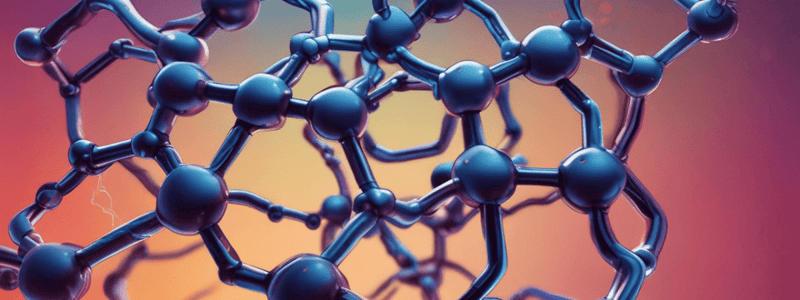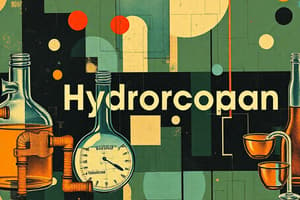Podcast
Questions and Answers
What is the general formula for alkenes?
What is the general formula for alkenes?
- CnHn
- CnHn+2
- CnH2n+2
- CnH2n (correct)
Which feature distinguishes an alkene structure?
Which feature distinguishes an alkene structure?
- Carbon-oxygen double bond
- Single bond between carbon and nitrogen
- Carbon-carbon double bond (correct)
- Presence of a triple bond
What is the common name given to the simplest alkene?
What is the common name given to the simplest alkene?
- Methane
- Butylene
- Ethylene (correct)
- Propylene
How are most alkenes named according to IUPAC rules?
How are most alkenes named according to IUPAC rules?
Why are alkenes referred to as unsaturated hydrocarbons?
Why are alkenes referred to as unsaturated hydrocarbons?
In the IUPAC naming system, what is indicated by a number in the parent chain?
In the IUPAC naming system, what is indicated by a number in the parent chain?
Which solvent are alkenes insoluble in?
Which solvent are alkenes insoluble in?
What is the main factor that determines the direction in which the main carbon chain is numbered in alkenes?
What is the main factor that determines the direction in which the main carbon chain is numbered in alkenes?
What physical property do alkenes share with alkanes?
What physical property do alkenes share with alkanes?
What type of isomerism is exhibited by alkenes with two different groups bonded to each carbon of the double bond?
What type of isomerism is exhibited by alkenes with two different groups bonded to each carbon of the double bond?
In cis-2-butene, where are the two methyl groups located relative to the double bond?
In cis-2-butene, where are the two methyl groups located relative to the double bond?
Why can't cis-2-butene and trans-2-butene be converted into one another at room temperature?
Why can't cis-2-butene and trans-2-butene be converted into one another at room temperature?
What is the process by which alkyl halides are converted into alkenes?
What is the process by which alkyl halides are converted into alkenes?
Why does n-Butyl chloride yield only 1-butene in the dehydrohalogenation reaction?
Why does n-Butyl chloride yield only 1-butene in the dehydrohalogenation reaction?
In dehydrohalogenation, what role does the hydroxide ion play?
In dehydrohalogenation, what role does the hydroxide ion play?
Why is 2-butene the chief product when sec-Butyl chloride undergoes dehydrohalogenation?
Why is 2-butene the chief product when sec-Butyl chloride undergoes dehydrohalogenation?
What type of bonds are broken in an unsymmetrical fashion during dehydrohalogenation?
What type of bonds are broken in an unsymmetrical fashion during dehydrohalogenation?
What is the characteristic hydroxyl group present in alcohols?
What is the characteristic hydroxyl group present in alcohols?
What is required for the process of dehydration to occur?
What is required for the process of dehydration to occur?
In the dehydration process, how can alcohols be heated to lead to the formation of alkenes?
In the dehydration process, how can alcohols be heated to lead to the formation of alkenes?
Which type of acid serves as a Lewis acid in the dehydration process of alcohols?
Which type of acid serves as a Lewis acid in the dehydration process of alcohols?
What is the role of a Lewis acid in the dehydration process?
What is the role of a Lewis acid in the dehydration process?
Which species forms from the dissociation of protonated alcohol in the dehydration process?
Which species forms from the dissociation of protonated alcohol in the dehydration process?
How is the alkene formed in the dehydration process from the carbonium ion?
How is the alkene formed in the dehydration process from the carbonium ion?
What is the term for a migration of hydrogen with a pair of electrons?
What is the term for a migration of hydrogen with a pair of electrons?
Which carbonium ion rearrangement yields predominantly 2-butene?
Which carbonium ion rearrangement yields predominantly 2-butene?
What type of compounds are vicinal dihalides?
What type of compounds are vicinal dihalides?
In alkene synthesis, what is the term for a migration of an alkyl group?
In alkene synthesis, what is the term for a migration of an alkyl group?
What determines whether a cis-alkene or a trans-alkene is yielded in the reduction of an alkyne?
What determines whether a cis-alkene or a trans-alkene is yielded in the reduction of an alkyne?
Which carbonium ion rearrangement involves a primary carbonium ion rearranging to a tertiary carbonium ion?
Which carbonium ion rearrangement involves a primary carbonium ion rearranging to a tertiary carbonium ion?
The migration of an alkyl group is known as an alkyl hydride shift.
The migration of an alkyl group is known as an alkyl hydride shift.
Isomeric alkenes formed during dehalogenation will always have the same chemical properties.
Isomeric alkenes formed during dehalogenation will always have the same chemical properties.
Reduction of an alkyne to the double-bond stage can yield only a trans-alkene.
Reduction of an alkyne to the double-bond stage can yield only a trans-alkene.
The reduction of alkynes to alkenes is solely dependent on the location of the triple bond within a chain.
The reduction of alkynes to alkenes is solely dependent on the location of the triple bond within a chain.
Vicinal dihalides are compounds with halogens on non-adjacent carbons.
Vicinal dihalides are compounds with halogens on non-adjacent carbons.
Dehalogenation of vicinal dihalides is a common method for the synthesis of alkanes.
Dehalogenation of vicinal dihalides is a common method for the synthesis of alkanes.
The 3,3-dimethyl-2-butyl cation rearranges to form the 2,3-dimethyl-2-butyl cation.
The 3,3-dimethyl-2-butyl cation rearranges to form the 2,3-dimethyl-2-butyl cation.
A hydride shift involves the migration of hydrogen along with a pair of electrons.
A hydride shift involves the migration of hydrogen along with a pair of electrons.
Isomeric alkenes formed during dehalogenation will have identical physical properties.
Isomeric alkenes formed during dehalogenation will have identical physical properties.
The 2-methyl-l -butyl cation rearranges to form the 2-methyl-1-butyl cation.
The 2-methyl-l -butyl cation rearranges to form the 2-methyl-1-butyl cation.
Flashcards are hidden until you start studying
Study Notes
Alkenes
- General formula: CnH2n
- Unsaturated hydrocarbons
- Simplest member: ethylene (C2H4)
- Carbon-carbon double bond:
- Consists of a strong σ bond and a weak π bond
- C-C distance in ethylene is less than in ethane
- Double bond is shorter than a single bond
Naming Alkenes
- IUPAC system:
- Select the longest continuous chain containing the double bond
- Indicate the position of the double bond with a number
- Carbon-carbon double bonds take precedence over alkyl groups and halogens
Physical Properties
- Insoluble in water, but soluble in nonpolar solvents (benzene, ether, chloroform)
- Boiling point increases with carbon number (like alkanes)
Cis, Trans Isomerism
- Restricted rotation about the carbon-carbon double bond
- Any alkene with different groups bonded to each carbon of the double bond shows cis, trans isomerism
- Example: 2-butene has two stereoisomers (cis-2-butene and trans-2-butene)
Preparation of Alkenes
-
- Dehydrohalogenation of alkyl halides:
- Elimination of hydrogen halide
- Example: n-Butyl chloride yields 1-butene, sec-Butyl chloride yields 1-butene and 2-butene
-
- Dehydration of alcohols:
- Requires an acid and heat
- Example: Ethyl alcohol yields ethylene
-
- Dehalogenation of vicinal dihalides:
- Vicinal dihalides are prepared by reacting a halogen with an alkene
-
- Reduction of alkynes:
- Yields either a cis-alkene or a trans-alkene depending on the reducing agent
Studying That Suits You
Use AI to generate personalized quizzes and flashcards to suit your learning preferences.




